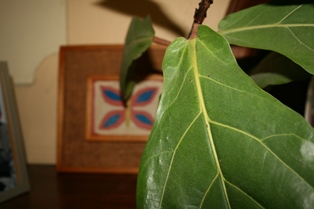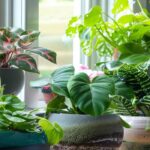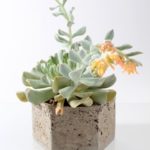Fiddle-Leaf Fig Takes Centerstage in Your Indoor Garden
Though the fiddleaf-fig (Ficus lyrata) comes from the humid jungle where it reaches 40 feet or taller, this head-turner does incredibly well in the much drier indoor environment. Give the plant medium-bright light and some encouragement, and it will tower 6 to 10 feet indoors.
As its name suggests, the large leathery, slightly shiny leaves of the fiddle-leaf are shaped like a fiddle and can reach more than 12 inches across and 6 inches wide. The plant grows slowly, but will eventually create an impressive tall floor plant that will add a tropical flair to any room.
To have luck growing fiddle-leaf fig, keep the following growing tips in mind.
Light for fiddle-leaf fig
Medium-bright light is ideal for the fiddle-leaf fig. The plant does well in an eastern exposure with direct morning sun, but avoid placing the plant in bright, direct afternoon sunlight, as the leaves will burn. If the plant is kept in insufficient light, it grows slowly, drops leaves and etiolates (stretches to any available light source). If necessary, place the plant under full-spectrum lighting.
To prevent the fiddle-leaf fig from stretching and growing in a distorted manner, turn the plant a quarter turn once a month, if possible.

Photo, Amy Bawden
Watering ficus lyrata
Fiddle-leaf fig prefers to remain moist, but not soggy. Water when the first half-inch of soil dries out. Always water with warm to tepid water—not cold. And don’t use softened water, as it’s high in salts, which will cause burn along the plant leaf rims and a toxic, eventually fatal salt build-up in the soil.
Provide rich soil for fiddle-leaf fig
Ficus lyrata does best when planted in a humus-rich mix. Choose a well-draining potting soil that is neutral to alkaline. For healthy plant growth, add worm compost when repotting and use it to top dress in between potting up.
Pot up ficus lyrata regularly
Repot every one to two years in spring or summer. If you wish to control the plant’s size, prune off 25 percent of the roots and repot in the same or similar size container. Otherwise, move up one pot size with each repotting. Ficus lyrata tend to be top-heavy, so plant in a ceramic pot that will prevent it from toppling, especially as it grows taller.

Photo, Julie Bawden-Davis
Feed fiddle-leaf fig periodically
Fertilize ficus lyrata every two months with an organic houseplant food that contains ingredients such as alfalfa meal, which is a natural growth hormone.
Provide humidity for fiddle-leaf fig
Though they can thrive in somewhat dry indoor air, fiddle-leaf figs do best when grown in 50 to 70 percent humidity. Provide additional humidity by growing the fiddle-leaf fig on a humidity tray and grouping plants, which humidify each other.
Pest and disease problems affecting fiddle-leaf fig
Ficus lyrata leaves have a tendency to spot, which stems from injury to the plants, either from bumping or bruising or from spider mites. The plant also contains a sap that can irritate human skin and the plant leaves themselves. Leaf-spotting is also a common fungal disease for the plant. This is caused by keeping the soil soggy and from a lack of airflow. To prevent spread of leaf diseases, remove spotted leaves when they appear and dispose of them.





